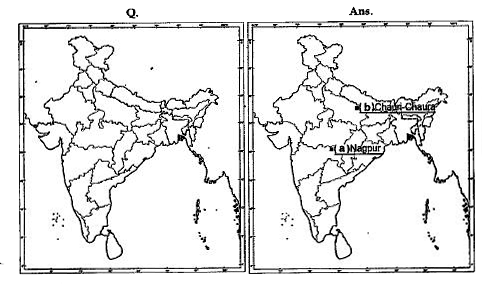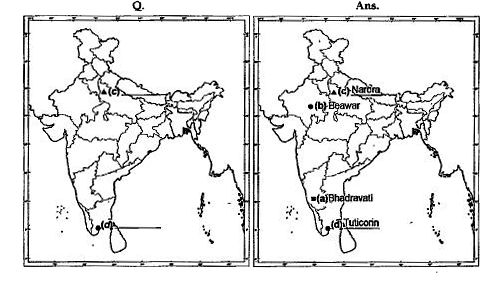Gandhiji hoped that by coupling non-cooperation with _______, India’s two major religious communities, Hindus and Muslims, could collectively bring an end to colonial rule.
Swadeshi Movement
Khilafat Movement
Sepoy Mutiny
Civil Disobedience Movement
The correct Answer is:B
Similar Questions
(i) Examine the causes and the contribution of the non-cooperation movement to India's freedom struggle.
(ii) Why did Gandhiji couple non-cooperation movement with Khilafat movement?View Solution(A) Locate and label the place on the given outline political map of India:
(a) The place where the Indian National Congress Session was held in December, 1920. 1
(b) The place where 22 policemen were burnt forcing Gandhiji to call off the Non cooperation Movement.

(B) The following features are to be located and labelled on the given India political outline map:
(a) Bhadrawati – Iron and Steel Plant
(b) Beawar-Mica Mine
Identify the features marked on the same given India political map and write their, names:
(c) Nuclear Power Plant
(d) Major Sea Port

(a) Name the place where the Indian National Congress session was held in December, 1920.
(b) Name the place where 22 policemen were burnt forcing Gandhiji to call off the Non-cooperation Movement.
(c) Name the nuclear plant located in Uttar Pradesh. (d) Name the iron and steel plant located in Chhattisgarh. (e) Which is the southernmost sea port of India?View Solution
Knowledge Check
- Question 1 - Select One
Read the source given below and answer the questions that follows: India is a multi-religious, multi-lingual, multi racial, and multi-cultural society. Religious minorities constitute roughly 20% of India's population, out of which Muslims account for 14.2%. No society can prosper or be at peace if its 20% of the population feels threatened, deprived, neglected and unwanted.
In multiple constitutional cases especially the S.R.Bommai case, Supreme Court has ruled that secularism forms the basic structure of the Indian Constitution. In the Ayodhya case also, the Court opined that the secular nature of India would form the basic structure of our Constitution, even if it hadn't been specifically mentioned in the Constitution. With the 42nd Amendment of the Constitution of India enacted in 1976, the Preamble to the Constitution asserted that India is a secular nation.
Secularism is the first and foremost doctrine that opposes all forms of inter-religious domination. Religion has its own share of some deep-rooted problems. In religions such as Hinduism, some sections have been persistently discriminated. Many religions are fragmented into sects, which leads to frequent sectarian violence and persecution of dissenting minorities. This religious domination is known as inter- religious domination.
Which of the two cases connected to communal tensions/ harmony are mentioned here?ARafale and 2G ScamBIshrat Jahan Encounter and Godhara caseC9/11 and 26/11 attacksDSR Bommai and Ayodhya - Question 2 - Select One
Read the source given below and answer the questions that follows: India is a multi-religious, multi-lingual, multi racial, and multi-cultural society. Religious minorities constitute roughly 20% of India's population, out of which Muslims account for 14.2%. No society can prosper or be at peace if its 20% of the population feels threatened, deprived, neglected and unwanted.
In multiple constitutional cases especially the S.R.Bommai case, Supreme Court has ruled that secularism forms the basic structure of the Indian Constitution. In the Ayodhya case also, the Court opined that the secular nature of India would form the basic structure of our Constitution, even if it hadn't been specifically mentioned in the Constitution. With the 42nd Amendment of the Constitution of India enacted in 1976, the Preamble to the Constitution asserted that India is a secular nation.
Secularism is the first and foremost doctrine that opposes all forms of inter-religious domination. Religion has its own share of some deep-rooted problems. In religions such as Hinduism, some sections have been persistently discriminated. Many religions are fragmented into sects, which leads to frequent sectarian violence and persecution of dissenting minorities. This religious domination is known as inter- religious domination.
What is the share of religious minorities in the Indian population?A15%B18%C20%D19% - Question 3 - Select One
Read the source given below and answer the questions that follows: India is a multi-religious, multi-lingual, multi racial, and multi-cultural society. Religious minorities constitute roughly 20% of India's population, out of which Muslims account for 14.2%. No society can prosper or be at peace if its 20% of the population feels threatened, deprived, neglected and unwanted.
In multiple constitutional cases especially the S.R.Bommai case, Supreme Court has ruled that secularism forms the basic structure of the Indian Constitution. In the Ayodhya case also, the Court opined that the secular nature of India would form the basic structure of our Constitution, even if it hadn't been specifically mentioned in the Constitution. With the 42nd Amendment of the Constitution of India enacted in 1976, the Preamble to the Constitution asserted that India is a secular nation.
Secularism is the first and foremost doctrine that opposes all forms of inter-religious domination. Religion has its own share of some deep-rooted problems. In religions such as Hinduism, some sections have been persistently discriminated. Many religions are fragmented into sects, which leads to frequent sectarian violence and persecution of dissenting minorities. This religious domination is known as inter- religious domination.
Which amendment of constitution states that India is a secular nation?A42nd amendmentB41st amendmentC44th amendmentD40th amendment
Read the passage given below and answer the questions that follow:
" A voice in the wilderness"
Mahatma Gandhiji knew that his was " a voice in the wilderness" but he nevertheless continued to oppose the idea of Partition:
But what a tragic change we see today. I wish the day may come again when Hindus and Muslims will do nothing without mutual consultation. I am day and night tormented by the question what I can do to hasten the coming of that day. I appeal to the League not to regard any Indian as its enemy .... Hindus and Muslims are born of the same soil. They have the same blood. eat the same food, drink the same water and speak the same language.
Speech at Prayer Meeting,
7 September 1946,
>CWMG, Vol ,92,
But I am firmly convinced that tha Pakistan demand as put forward by the Muslim League is un-Islamic and I have not hesitated to call it sinful. Islam stands for the unity and brotherhood of mankind, not for disrupting the onenesss of the human family. Therefore , those who want to divide India into possible warring groups are enemies alike of Islam and India. They may cut me to pieces but they cannot make me subscribe to something which I consider to be wrong.
Harijan 26 September 1946,
CWMG, Vol.92,P,229
What two arguments did Gandhiji give against partition?View SolutionRead the source given below and answer the questions that follows: India is a multi-religious, multi-lingual, multi racial, and multi-cultural society. Religious minorities constitute roughly 20% of India's population, out of which Muslims account for 14.2%. No society can prosper or be at peace if its 20% of the population feels threatened, deprived, neglected and unwanted.
In multiple constitutional cases especially the S.R.Bommai case, Supreme Court has ruled that secularism forms the basic structure of the Indian Constitution. In the Ayodhya case also, the Court opined that the secular nature of India would form the basic structure of our Constitution, even if it hadn't been specifically mentioned in the Constitution. With the 42nd Amendment of the Constitution of India enacted in 1976, the Preamble to the Constitution asserted that India is a secular nation.
Secularism is the first and foremost doctrine that opposes all forms of inter-religious domination. Religion has its own share of some deep-rooted problems. In religions such as Hinduism, some sections have been persistently discriminated. Many religions are fragmented into sects, which leads to frequent sectarian violence and persecution of dissenting minorities. This religious domination is known as inter- religious domination.
Sectarian violence of a religion is known as _______View SolutionWhich of the following statements with regard to freedom struggle are correct?
1. The British rule could prevail in India on the basis of the consent or acquiescence of many sections of Indian people.
2. The social basis of the colonial regime was among the Zamindars and upper classes.
3. The Indian National Army forced the British to with from India.
4. The Hindu Mahasabha supported the partition of India.
Select the correct answer using the code given below:
Code:View SolutionRead the passage carefully and choose the best answer to each question out of the four alternatives and click the button corresponding to it.
"Tryst with Destiny" was a speech delivered by Jawaharlal Nehru, the first Prime Minister of independent India, to the Indian Constituent Assembly in Parliament, on 14th August 1947. It is considered to be one of the greatest speeches of all times and to be a landmark oration that captures the essence of the triumphant culmination of the largely non-violent Indian independence struggle against the British Empire in India.
..Long years ago we made a tryst with destiny, and now the time comes when we shall redeem our pledge, not wholly or in full measure, but very substantially. Freedom and power bring responsibility. The responsibility rests upon the assembly, a sovereign body representing the sovereign people of India. The service of India means the service of the millions who suffer. It means the ending of poverty and ignorance and disease and inequality of opportunity. We cannot encourage communalism or narrow-mindedness, for no nation can be great whose people are narrow in thought or in action.
To the people of India, whose representatives we are, this is no time for petty and destructive criticism, no time for ill will or blaming others. We have to build the noble mansion of free India where all her children may dwell...
Select the answer which best reflects Nehru.s point of view.View SolutionRead the passage carefully and choose the best answer to each question out of the four alternatives and click the button corresponding to it.
"Tryst with Destiny" was a speech delivered by Jawaharlal Nehru, the first Prime Minister of independent India, to the Indian Constituent Assembly in Parliament, on 14th August 1947. It is considered to be one of the greatest speeches of all times and to be a landmark oration that captures the essence of the triumphant culmination of the largely non-violent Indian independence struggle against the British Empire in India.
..Long years ago we made a tryst with destiny, and now the time comes when we shall redeem our pledge, not wholly or in full measure, but very substantially. Freedom and power bring responsibility. The responsibility rests upon the assembly, a sovereign body representing the sovereign people of India. The service of India means the service of the millions who suffer. It means the ending of poverty and ignorance and disease and inequality of opportunity. We cannot encourage communalism or narrow-mindedness, for no nation can be great whose people are narrow in thought or in action.
To the people of India, whose representatives we are, this is no time for petty and destructive criticism, no time for ill will or blaming others. We have to build the noble mansion of free India where all her children may dwell...
To whom did Nehru deliver this famous speech?View Solution

